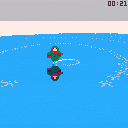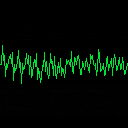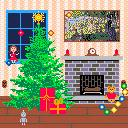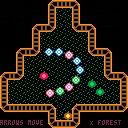PICO DAW is a digital audio workstation for creating PICO-8 tunes. If you've ever been frustrated by the piano style layout keyboard layout of the music editor or just wished you could draw your music, PICO DAW is for you. It's a mouse-based alternative for tune creation.
Preliminaries
While you can use the version of PICO DAW embedded in this page, it is better to run the cartridge directly from PICO-8. Open the PICO-8 console and enter [kbd]LOAD #DAW[kbd].
By default PICO-8 saves your composition to DAW.P8, but you can specify a different cart as the target by changing the file specified in the first line of code of the PICO DAW cart: target="daw.p8". If you are using a pre-exiting P8 file as the target, that file must be in the same folder as PICO DAW. If PICO DAW does not find the target file in the default folder, it will create one with the music patterns and SFX copied from PICO-DAW.




Old Man Winter and Santa Claus have been feuding all year. It started with yard signs and then things escalated. Now OMW is blowing up a big storm on Christmas Eve!
You, Jack Frost, must blow away the snow so that Santa can get out and make his deliveries.
Controls
Controls are simple. Just use 🅾️ (Z key on computer keyboard) to blow a puff air. This propels jack backward and changes the air currents to redirect the snow, hopefully away from Santa's house.
Credits
Art, SFX, music and coding by @bikibird
with easing functions borrowed from https://www.lexaloffle.com/bbs/?tid=40577
and tline rotation borrowed from
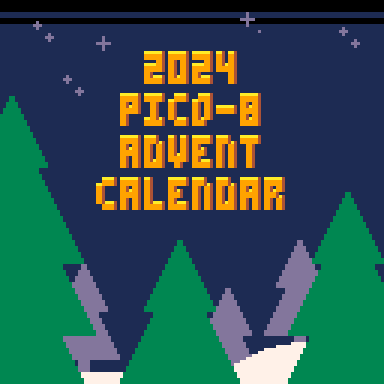
Good news! After intensive labor negotiations, Santa's elves have decided not to go on strike. In an effort to meet the elves' demands for less stress and more fun, management has agreed to start the PICO-8 Advent Calendar Bundle a few weeks earlier than normal and manage the project with a game jam on Itch. We're hoping to get far more participants than last year and streamline the onboarding process. Please don your elf cap and join us. https://itch.io/jam/pico-8-advent-calendar-2024


Album is a collection of music visualizers for the PICO-8 Free Music Jam. Just add your music, cover art, and a little bit of meta-data to make your own album.
Controls
Press ⬆️ to dismiss the credit for the tune.
Press ⬇️ to see the credit.
Press ⬅️ to listen to the previous tune.
Press ➡️ to listen to the next tune.
Press ❎ or 🅾️ to replay a tune.
Suggested workflow
- From the PICO-8 console
load #album. - Save the album under a new name to make it yours.
- Create your music in the cart or manually copy the SFXes and music pattern from another cart.
- Replace the cover art and label.
Help Santa pass his audition with the Norse Ursine Merriment Band.
Hints:
Credits:
Created for the PICO-8 Holiday Bundle 2023
Label Art by @paraK00PA
Jingle Bells by James Lord Pierpont
We Wish You a Merry Christmas popularized by Arthur Warrell
Everything else by @bikibird
ZOMG! I just realized it's October already! The PICO-8 advent calendar is just around the corner. Or, maybe not... We're still looking for tons more people to contribute a winter holiday themed PICO-8 project to the calendar. It doesn't have to be an epic masterpiece. Small games and demos are welcome. You can even reskin a game you previously released.
If you're interested, make sure you've joined the PICO-8 Discord server and then see https://discord.com/channels/215267007245975552/220602714982318081/1146905525158682665 for info on how to contribute, cuz we sure need you.
I wrote a music theory tutorial for PICO-8, available here: https://bikibird.itch.io/music-theory. It's designed for people who want to make their own music for PICO-8 games, but feel they don't have the skill or talent to do so.
The tutorial provides an introduction to the basics of pitch, melody, harmony, rhythm and composition within the context of PICO-8. It explores music in a decidedly mathy way through a series of interactive demos that use spatial relations to connect sound to vision.
Only the parts of music theory that are relevant to PICO-8 are covered. No prior knowledge of music is assumed. There's no reading sheet music or needing to play an instrument.
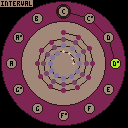




You were so excited to try your brand new skates on Christmas day that you skated out to the middle of the lake without checking the ice conditions. Now you are on thin ice and just want to get back to your friend on the shore.
Game Play
Control your skates with the left and right buttons. Alternate left and right to speed up. Hold to turn. You haven't exactly learned to stop yet, but if you start turning circles, you will eventually slow down. You can walk on the snow, but it is very slow.
Credits:
Music composed by Vince Guaraldi
Christmas Time Is Here arranged by @Gruber
3d effects: @Mot's Instant 3d Plus Library







This is the year you find out if Santa is really real. You and your siblings are staying up late to finally get proof. The light are out, but you're not scared!
Game Play
Requires mouse. Hold down left mouse button to turn on flashlight. Drag mouse across screen to catch Santa in the act. Press ❎ to snap a picture.
Credits
Up on the Housetop composed by Benjamin Hanby
Midilib flute by @ericb https://www.lexaloffle.com/bbs/?tid=49487
Flashlight effect informed by @Krystman https://www.lexaloffle.com/bbs/?tid=46286
Fizzle fader borrowed from @DrPete https://www.lexaloffle.com/bbs/?tid=29862
Everything else by @bikibird
Created for the



Add speech synthesis to your games with Speako8, a speech synthesis library for PICO-8 in under a thousand tokens! It's loosely based on a Klatt synthesizer and will remind some folks of Software Automatic Mouth (S.A.M.)
To add Speako8 to your games, copy and paste the library below:
[hidden]
--speako8_lib_min by bikibird
do d=split("aa=1320,1,500,4,2,0,1,2600,160,1220,70,700,130,-250,100;ae=1270,1,1000,4,2,0,.79,2430,320,1660,150,620,170,-250,100;ah=770,1,1000,4,2,0,.79,2550,140,1220,50,620,80,-250,100;ao=1320,1,1000,4,2,0,.74,2570,80,990,100,600,90,-250,100;aw=720,1,1000,4,2,0,.79,2550,140,1230,70,640,80,-250,100/720,1,1000,4,3,0,0,2350,80,940,70,420,80,-250,100;ay=690,1,1000,4,2,0,.9,2550,200,1200,70,660,100,-250,100/690,1,1000,4,2,0,.223,2550,200,1880,100,400,70,-250,100;eh=830,1,1000,4,2,0,.44,2520,200,1720,100,480,70,-250,100;er=990,1,1000,4,2,0,.41,1540,110,1270,60,470,100,-250,100;ey=520,1,500,4,2,0,.44,2520,200,1720,100,480,70,-250,100/520,1,500,4,2,0,.05,2600,200,2020,100,330,50,-250,100;ih=720,1,1000,4,2,0,.23,2570,140,1800,100,400,50,-250,100;iy=880,1,1000,4,2,0,0,2960,400,2020,100,310,70,-250,100;ow=1210,1,1000,4,2,0,.59,2300,70,1100,70,540,80,-250,100;oy=513,1,1000,4,2,0,.62,2400,130,960,50,550,60,-250,100/513,1,1000,4,2,0,.13,2400,130,1820,50,360,80,-250,100/513,1,1000,4,2,0,.13,2400,130,1820,50,360,80,-250,100;uh=880,1,1000,4,2,0,.36,2350,80,1100,100,450,80,-250,100;uw=390,1,1000,4,2,0,.1,2200,140,1250,110,350,70,-250,100/390,1,1000,0,1,0,-.12,2200,140,900,110,320,70,-250,100/390,1,1000,0,0,0,-.12,2200,140,900,110,320,70,-250,100;l=440,1,1000,0,2,0,0,2880,280,1050,100,310,50,-250,100;r=440,1,1000,0,2,0,0,1380,120,1060,100,310,70,-250,100;m=390,1,1000,0,0,0,0,2150,200,1100,150,400,300,-450,100;n=360,1,1000,0,0,0,0,2600,170,1600,100,200,60,-450,100;ng=440,1,1000,0,0,0,0,2850,280,1990,150,200,60,-450,100;ch=230,0,20,0,0,1,0,2820,300,1800,90,350,200,-250,100/100,0,100,1,0,1,0,2820,300,1800,90,350,200,-250,100;sh=690,0,20,0,0,1,0,2750,300,1840,100,300,200,-250,100;zh=1,1,250,0,0,.5,0,2750,300,1840,100,300,200,-250,100/385,1,400,1,0,.5,0,2750,300,1840,100,300,200,-250,100;jh=330,1,500,1,0,1,0,2820,270,1800,80,260,60,-250,100;dh=275,1,250,0,0,.5,0,2540,170,1290,80,270,60,-250,100;f=1,0,15,0,0,1,0,2080,150,1100,120,340,200,-250,100/660,0,25,1,0,1,0,2080,150,1100,120,340,200,-250,100;s=690,0,10,0,0,1,0,2530,200,1390,80,320,200,-250,100;k=88,0,100,0,0,1,0,2850,330,1900,160,300,250,-250,100/220,2,5,1,0,1,0,2850,330,1900,160,300,250,-250,100;p=44,0,50,0,0,1,0,2150,220,1100,150,400,300,-250,100/220,2,2,1,0,1,0,2150,220,1100,150,400,300,-250,100;t=66,0,100,0,0,2,0,2600,250,1600,120,400,300,-250,100/220,2,5,0,0,1,0,2600,250,1600,120,400,300,-250,100;g=88,0,100,0,0,1,0,2850,280,1990,150,200,60,-250,100;b=44,0,100,0,1,0,0,2150,220,1100,150,400,300,-250,100;d=66,0,100,0,0,1,0,2600,170,1600,100,200,60,-250,100;th=606,0,10,0,0,1,0,2540,200,1290,90,320,200,-250,100;v=330,1,1000,0,0,.5,0,2080,120,1100,90,220,60,-250,100;z=410,1,1000,0,0,.5,0,2530,180,1390,60,240,70,-250,100;w=440,1,1000,0,0,0,.1,2150,60,610,80,290,50,-250,100;y=440,1,1000,0,0,0,0,3020,500,2070,250,260,40,-250,100;",";")x={}for a in all(d)do local e=split(a,"=")local d,a=e[1],split(e[2],"/")x[d]={}for e in all(a)do local a=split(e)local e={unpack(a,1,7)}e[8]={}for x=8,14,2do add(e[8],{unpack(a,x,x+1)})end add(x[d],e)end end poke(24374,@24374^^32)local 𝘤,y,𝘥,g,z,𝘦,d,r,n,b,m,𝘧,s,u,j,𝘨,𝘩,𝘪,o,f,l=unpack(split"0,0,0,0,0,0,0,0,0,0,0x8000,0x1.233b,-0x.52d4")local c,w,i,h,𝘫,𝘬,k,t,p,v,q,𝘢,𝘣={}e=split"2,0x1.fd17,0x1.fa32,0x1.f752,0x1.f475,0x1.f19d,0x1.eec9,0x1.ebfa,0x1.e92e,0x1.e666,0x1.e3a3,0x1.e0e3,0x1.de27,0x1.db70,0x1.d8bc,0x1.d60c,0x1.d360,0x1.d0b9,0x1.ce14,0x1.cb74,0x1.c8d8,0x1.c63f,0x1.c3aa,0x1.c119,0x1.be8c,0x1.bc02,0x1.b97c,0x1.b6fa,0x1.b47b,0x1.b200,0x1.af89,0x1.ad15,0x1.aaa5,0x1.a838,0x1.a5cf,0x1.a369,0x1.a107,0x1.9ea9,0x1.9c4d,0x1.99f6,0x1.97a1,0x1.9550,0x1.9302,0x1.90b8,0x1.8e71,0x1.8c2e,0x1.89ed,0x1.87b0,0x1.8576,0x1.8340,0x1.810c,0x1.7edc,0x1.7caf,0x1.7a85,0x1.785f,0x1.763b,0x1.741b,0x1.71fd,0x1.6fe3,0x1.6dcc,0x1.6bb8,0x1.69a7,0x1.6798,0x1.658d,0x1.6385,0x1.6180,0x1.5f7e,0x1.5d7e,0x1.5b82,0x1.5988,0x1.5792,0x1.559e,0x1.53ad,0x1.51bf,0x1.4fd3,0x1.4deb,0x1.4c05,0x1.4a22,0x1.4842,0x1.4664,0x1.4489,0x1.42b1,0x1.40dc,0x1.3f09,0x1.3d39,0x1.3b6b,0x1.39a0,0x1.37d8,0x1.3612,0x1.344f,0x1.328f,0x1.30d1,0x1.2f15,0x1.2d5c,0x1.2ba6,0x1.29f2,0x1.2841,0x1.2692,0x1.24e5,0x1.233b,0x1.2193,0x1.1fee,0x1.1e4b,0x1.1cab,0x1.1b0c,0x1.1971,0x1.17d7,0x1.1640,0x1.14ab,0x1.1319,0x1.1189,0x1.0ffb,0x1.0e6f,0x1.0ce5,0x1.0b5e,0x1.09d9,0x1.0857,0x1.06d6,0x1.0558,0x1.03db,0x1.0261,0x1.00e9,0x.ff74,0x.fe00,0x.fc8f,0x.fb1f,0x.f9b2,0x.f847,0x.f6dd,0x.f576,0x.f411,0x.f2ae,0x.f14d,0x.efee,0x.ee91,0x.ed36,0x.ebdd,0x.ea86,0x.e930,0x.e7dd,0x.e68c,0x.e53c,0x.e3ef,0x.e2a3,0x.e15a,0x.e012,0x.decc,0x.dd88,0x.dc45,0x.db05,0x.d9c6,0x.d889,0x.d74e,0x.d615,0x.d4de,0x.d3a8,0x.d274,0x.d142,0x.d012,0x.cee3,0x.cdb6,0x.cc8b,0x.cb61,0x.ca39,0x.c913,0x.c7ee,0x.c6cc,0x.c5aa,0x.c48b,0x.c36d,0x.c251,0x.c136,0x.c01d,0x.bf05,0x.bdef,0x.bcdb,0x.bbc8,0x.bab7,0x.b9a7,0x.b899,0x.b78d,0x.b682,0x.b578,0x.b470,0x.b36a,0x.b265,0x.b161,0x.b05f,0x.af5f,0x.ae5f,0x.ad62,0x.ac66,0x.ab6b,0x.aa71,0x.a979,0x.a883,0x.a78e,0x.a69a,0x.a5a8,0x.a4b7,0x.a3c7,0x.a2d9,0x.a1ec,0x.a100,0x.a016,0x.9f2d,0x.9e45,0x.9d5f,0x.9c7a,0x.9b97,0x.9ab4,0x.99d3,0x.98f3,0x.9815,0x.9738,0x.965c,0x.9581,0x.94a7,0x.93cf,0x.92f8,0x.9222,0x.914e,0x.907a,0x.8fa8,0x.8ed7,0x.8e07,0x.8d39,0x.8c6b,0x.8b9f,0x.8ad4,0x.8a0a,0x.8941,0x.8879,0x.87b3,0x.86ed,0x.8629,0x.8566,0x.84a4,0x.83e3,0x.8323,0x.8264,0x.81a7,0x.80ea,0x.802e,0x.7f74,0x.7eba,0x.7e02,0x.7d4b,0x.7c94,0x.7bdf,0x.7b2b,0x.7a78,0x.79c6,0x.7915,0x.7864,0x.77b5,0x.7707,0x.765a,0x.75ae,0x.7503,0x.7458,0x.73af,0x.7307,0x.725f,0x.71b9,0x.7114,0x.706f,0x.6fcb,0x.6f29,0x.6e87,0x.6de6,0x.6d46,0x.6ca7,0x.6c09,0x.6b6c,0x.6ad0,0x.6a35"a=split"1,0x.fd19,0x.fa3a,0x.f764,0x.f497,0x.f1d1,0x.ef13,0x.ec5e,0x.e9b0,0x.e70a,0x.e46c,0x.e1d5,0x.df46,0x.dcbe,0x.da3d,0x.d7c4,0x.d552,0x.d2e7,0x.d083,0x.ce26,0x.cbd0,0x.c981,0x.c738,0x.c4f6,0x.c2bb,0x.c086,0x.be57,0x.bc2f,0x.ba0d,0x.b7f1,0x.b5dc,0x.b3cc,0x.b1c2,0x.afbf,0x.adc1,0x.abc9,0x.a9d6,0x.a7e9,0x.a602,0x.a421,0x.a244,0x.a06e,0x.9e9c,0x.9cd0,0x.9b09,0x.9947,0x.978a,0x.95d3,0x.9420,0x.9272,0x.90c9,0x.8f25,0x.8d86,0x.8beb,0x.8a55,0x.88c4,0x.8737,0x.85af,0x.842b,0x.82ac,0x.8130,0x.7fba,0x.7e47,0x.7cd9,0x.7b6e,0x.7a08,0x.78a6,0x.7748,0x.75ee,0x.7498,0x.7346,0x.71f7,0x.70ad,0x.6f66,0x.6e22,0x.6ce3,0x.6ba7,0x.6a6f,0x.693a,0x.6809,0x.66db,0x.65b0,0x.6489,0x.6366,0x.6245,0x.6128,0x.600e,0x.5ef7,0x.5de4,0x.5cd3,0x.5bc6,0x.5abc,0x.59b5,0x.58b0,0x.57af,0x.56b1,0x.55b5,0x.54bc,0x.53c7,0x.52d4,0x.51e3,0x.50f6,0x.500b,0x.4f22,0x.4e3d,0x.4d5a,0x.4c79,0x.4b9c,0x.4ac0,0x.49e7,0x.4911,0x.483d,0x.476b,0x.469c,0x.45cf,0x.4505,0x.443c,0x.4376,0x.42b3,0x.41f1,0x.4132,0x.4075,0x.3fba,0x.3f01,0x.3e4a,0x.3d95,0x.3ce3,0x.3c32,0x.3b83,0x.3ad7,0x.3a2c,0x.3983,0x.38dc,0x.3837,0x.3794,0x.36f3,0x.3653,0x.35b6,0x.351a,0x.3480,0x.33e8,0x.3351,0x.32bc,0x.3229,0x.3197,0x.3107,0x.3079,0x.2fed,0x.2f62,0x.2ed8,0x.2e50,0x.2dca,0x.2d45,0x.2cc2,0x.2c40,0x.2bbf,0x.2b40,0x.2ac3,0x.2a47,0x.29cc,0x.2953,0x.28db,0x.2864,0x.27ef,0x.277b,0x.2709,0x.2698,0x.2628,0x.25b9,0x.254b,0x.24df,0x.2474,0x.240a,0x.23a2,0x.233b,0x.22d4,0x.226f,0x.220b,0x.21a9,0x.2147,0x.20e6,0x.2087,0x.2029,0x.1fcb,0x.1f6f,0x.1f14,0x.1eba,0x.1e60,0x.1e08,0x.1db1,0x.1d5b,0x.1d06,0x.1cb2,0x.1c5e,0x.1c0c,0x.1bbb,0x.1b6a,0x.1b1b,0x.1acc,0x.1a7e,0x.1a31,0x.19e5,0x.199a,0x.1950,0x.1907,0x.18be,0x.1876,0x.182f,0x.17e9,0x.17a4,0x.175f,0x.171b,0x.16d8,0x.1696,0x.df50,0x.1614,0x.15d3,0x.1594,0x.1556,0x.1518,0x.14da,0x.149e,0x.cbd9,0x.1427,0x.13ec,0x.13b3,0x.137a,0x.1341,0x.1309,0x.12d2,0x.ba15,0x.1265,0x.1230,0x.11fb,0x.11c7,0x.1193,0x.1160,0x.112e,0x.a9de,0x.10cb,0x.109a,0x.106a,0x.103a,0x.100b,0x.0fdd,0x.0faf,0x.9b10,0x.0f54,0x.0f28,0x.0efc,0x.0ed0,0x.0ea5,0x.0e7b,0x.0e51,0x.8d8c,0x.0dfe,0x.0dd6,0x.0dad,0x.0d86,0x.0d5e,0x.0d38,0x.0d11,0x.8136,0x.0cc6,0x.0ca1,0x.0c7c,0x.0c58,0x.0c34,0x.0c11,0x.0bee,0x.0bcb,0x.0ba9,0x.0b87,0x.0b66,0x.0b45,0x.0b24,0x.0b03"function say(e)local p=split(e,"/")local d,e,a,n,t,f,m,j,r,v={},{}local s,b,u,w,y,g=unpack(split"1,1,0,0,0,0")for z in all(p)do local p=tonum(z)if p then local a=abs(p)local e,d,x=sgn(p),a\1,a&.99999
if(d==1)b=1+e*x
if(d==2)s=1+e*x
if d==3then u=e
if(x>0)u*=x
end elseif z=="hh"then g=b*440elseif z=="_"then add(c,{1100*b*spk8_rate})else for p in all(x[z])do f,o,m,j,r,i,h,k=unpack(p)a,n,t,v,d,w,e,y={},{},{},f*b,e,y,k,m l=u*spk8_intonation+h*spk8_if0
if(j==0)w=m
if(r==0or#d~=#e)d=k
for c=1,#d do add(a,{unpack(d[c])})local x,d=a[c],e[c]local e,a=r*(d[1]-x[1]),r*(d[2]-x[2])x.x,x.e,x.d=0,0,0if c<4then e*=spk8_shift a*=spk8_bandwidth end add(n,e/f)add(t,a/f)end if g>0then add(c,{g,2,0,1,0,1,h,a,n,t,e,s,l})g=0end add(c,{v,o,i,w,j*(y-w)/f,y,h,a,n,t,e,s,l})end s,b,u=1,1,0end end end function speaking()return#c>0end function mute()c={}b=0end function speako8()local function x()f=(5512.5/(spk8_pitch+l)+(f and f*49or 0))/(f and 50or 1)end if#c>0then w=c[1]while stat(108)<1920do for k=0,127do if w then if b<1then b,o,i,u,j,𝘨,h,𝘫,𝘩,𝘪,𝘬,𝘣,l=unpack(w)b/=spk8_rate end if o then x()t,d,p=spk8_quality*f,u/8,o*spk8_whisper if p==1then if n%flr(f+.5)==0then r,q,n=-d/(f-1),-d/t/t,0v=-q*t/3x()end if n>t then r=-d/(f-1)else v+=q r-=v end d=r elseif p>1then d=-8for x=1,16do d+=rnd()end
if(n>f\2)d/=2
end for n,x in pairs(𝘫)do local b,c,f,o=x[1],x[2]\10+1c=c<=#e and c or#e c=c>=1and c or 1𝘢=cos(b/5512.5)if b>0then f,o=e[c]*𝘢,-a[c]x.d,x.e,x.x=x.e,x.x x.x=(1-f-o)*d+f*x.e+o*x.d d=x.x elseif b<0then f=𝘧*𝘢 local x=1-f-s 𝘤=(d-f*y-s*𝘥)/x 𝘥,y,f=y,d,𝘧*cos(.04897)g=(1-f-s)*𝘤+f*z+s*𝘦 𝘦,z=z,g d=g end local e=𝘬[n]
if(b\10~=e[1]\10)x[1]+=𝘩[n]
if(c-1~=e[2]\10)x[2]+=𝘪[n]
end d*=i/2-1+rnd(i)
if(abs(u-𝘨)>abs(j))u+=j
else d,𝘣=0,1end n+=1b-=1poke(m+k,d*spk8_volume*𝘣+128)if b<1then deli(c,1)if#c==0then serial(2056,m,k+1)return else w=c[1]end end end end serial(2056,m,128)end end end end
--end of speako8_lib_min
|



.jpg)





Defy Audio Player
The Defy Audio Player plays Defy formatted audio files via PICO-8's PCM channel. It's a PCM boombox! You can also use it to create binary strings of audio data for playback in your own cartridges.
Convert almost any audio file format to .defy here: https://bikibird.itch.io/defy.
This cart is intended to run in PICO-8, not play on the BBS, which is limited to a maximum files size of 250K. Instead, open PICO-8 and enter load #defy. Then enter run.
Controls
- Drag and drop your .defy file onto PICO-8 to play it. You do not have to wait for a file to finish before loading another.
- Press 🅾️ (z key) to pause playback. Press it again to resume.










Lektrik Sportz Game
A Captain Neat-o Adventure
Let's get one thing straight. This is not Electric Football™. Doctor Lamento destroyed the football years ago because, you know, he's evil. But, I get ahead of myself. This is the story of Captain Neat-o who is far from home and falls into the clutches of Doctor Lamento.
The evil Doctor forces our hero to face off against his most formidable opponent, Neat-o himself, in a spectacle the Doctor calls Lektrik Sportz Game (because he can't spell and, you know, he's evil.)
Game Play
Run from one end of the field to the other while avoiding your opponents. You should make it home in under 5 minutes. Don't fall off.


This is the story of a hard working Christmas elf. I was never told their name. I call them Blinky. They had one last task to complete late one Christmas Eve: String some lights, plug them in, and connect them to the finial atop the tree. Easy for a smart elf like Blinky. Too bad they never finished that electrician's course...
Game Play
Connect the loose bulbs by touching them with the exposed wire from the light string. Loose bulbs are always safe, but if the string is connected to power and you touch the string to itself, some of the bulbs will explode. Electricity is powerful, but dangerous. Be careful with it.
There are three possible endings and eleven achievements to earn.

I made a web-based tool for extracting and converting MIDI file data to be played in PICO-8. It's nicely interactive and includes a PICO-8 console built into the page so that you can audition the results before you copy the SFX data. Give Denote a try and let me know what you think.








So, I've been working on a web based MIDI to PICO-8 converter for a while now. It was going pretty well, but today I introduced a bug, which totally corrupted the SFX data. The input was the traditional melody, Ghost Of John. The output was this:
Surprisingly, I like the way it sounds. I guess I composed some original music here, but it was completely accidental. I guess if you make enough mistakes, some of them are bound to turn out ok.
Now I just need to figure out what kind of game goes with this soundtrack. Any suggestions? Feel free to use this in your own projects if it fits.
In my last game, I included an iris effect to transition between two scenes. I used the midpoint circle algorithm to calculate the edges of the iris. This algo avoids trig and square root functions and so is super fast. Even at 60 frames a second, there's no lag. I decided to make a more generalized version, implemented as a coroutine. I hope you find it useful for your projects.
To use:
-
Copy the iris function from the cartridge above into your own cartridge.
-
When it's time for a transition, assign the coroutine to a variable in your update function:
effect = cocreate(iris) - In the draw function, call the coroutine:
coresume(effect, 1, 128, 1, 15)

Straight from the laboratory of Professor von Stroopwafel is a modest proposal to solve global climate change. Enjoy a lighthearted romp through a speculative future. It even has bells and whistles. Happy Earth Day, everyone.
Game Play
Catch falling scoops of ice cream and toppings to fulfill as many orders as possible before the timer runs out.
Controls
Press the X key to advance to the next screen.
Left and right keys move the cone.
Use the Z key at any time to see the ice cream order. Press Z again to dismiss it. The timer is always running so try not to look at the order too long or too often.


I made an image demake tool for PICO-8. Load any image and create a dithered image that uses PICO-8 standard colors and/or hidden colors and is reduced to a maximum width and height of 128 x128. Depict supports Ordered, Atkinson, Floyd-Steinberg, and Sierra2 dithering as well as some artistic dithers: Rivers, Streets, Rain, Wind. Drag and drop the final result into the PICO-8 sprite sheet. Free on itch: Depict
All feedback welcomed.
Mix and match standard and hidden colors, but do do not exceed 16.
.png)
Rivers dither adds horizontal ripples.
.png)
Streets dither creates maze-like artifacts.
.png)
Rain dither makes vertical steaks.
.png)
Wind dither produces slashes.
.png)
Atkinson Dither
.png)



My first Pico-8 game. Entered in Toy Box Jam 2020.
Tis the season to sing carols, drink nog, and decorate the night with Christmas sneks.
Press an arrow key to change the direction of the snek and connect bulbs to the live wire at the front of the snek to light them up. Build a long snek or a short snek. Ride the high speed rail to get around faster.
This is a mellow game with no set goals, but beware! If you touch the live wire to the snek you will create a short circuit!
When you are happy with your snek, press X to go to the forest and plant a tree decorated with your snek. Then go build another snek so you can plant another tree.
Merry Christmas and may 2021 bring you only good things.









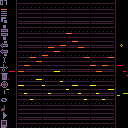
 13 comments
13 comments



